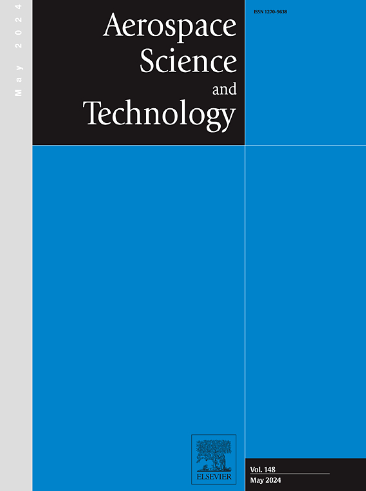Optimizing unmanned aerial vehicle aerodynamics: a two-stage approach using genetic algorithms and adjoint methods
IF 5.8
1区 工程技术
Q1 ENGINEERING, AEROSPACE
引用次数: 0
Abstract
In this article, we discuss the design of a flying wing using a default model and the application of the Taguchi test design method, genetic evolutionary optimization algorithm, and adjoint derivative optimization method, along with fluid dynamics calculations. Simulations were conducted using compressible Reynolds-averaged equations based on the Large Eddy Simulation (LES) turbulence model and the k-ω Shear Stress Transport (SST) model at a speed of 50 m/s and a Reynolds number of 1.6 million. The first stage of optimization was performed on the wing sections using the adjoint method. Subsequently, the second and third stages were optimized through a response surface method and genetic algorithm, involving 11 variables across these stages with a total of 50 tests conducted. The test case is a lambda-shaped flying wing named Saccon, which features wings with a 53-degree sweep angle. In this research, in order to optimize the lift coefficient and the ratio of lift to drag coefficients, a target function has been defined for the lift-to-drag ratio. By selecting this objective, both the lift and the lift-to-drag ratio can be increased. The results indicate that the impact of the variables varies for each section of the wing. Ultimately, the newly designed body achieved a 10% increase in aerodynamic efficiency compared to the default model through the use of optimization algorithms. Additionally, the drag coefficient increased by 140%, successfully completing the design process with multi-stage optimization techniques.
优化无人机空气动力学:采用遗传算法和伴随方法的两阶段方法
在本文中,我们讨论了使用默认模型的飞翼设计,并应用田口试验设计方法、遗传进化优化算法和伴随导数优化方法,以及流体动力学计算。采用基于大涡模拟(LES)湍流模型和k-ω剪切应力输运(SST)模型的可压缩雷诺数平均方程,在速度为50 m/s、雷诺数为160万的条件下进行了模拟。采用伴随法对机翼截面进行了第一阶段的优化。随后,通过响应面法和遗传算法对第二阶段和第三阶段进行优化,涉及11个变量,共进行了50次试验。测试用例是一种名为sacon的lambda形状的飞翼,其机翼的后掠角为53度。在本研究中,为了优化升力系数和升阻系数比,定义了升阻比的目标函数。通过选择这一目标,可以提高升力和升阻比。结果表明,各变量对机翼不同截面的影响是不同的。最终,通过使用优化算法,新设计的车身与默认模型相比,气动效率提高了10%。此外,阻力系数提高了140%,通过多级优化技术成功完成了设计过程。
本文章由计算机程序翻译,如有差异,请以英文原文为准。
求助全文
约1分钟内获得全文
求助全文
来源期刊

Aerospace Science and Technology
工程技术-工程:宇航
CiteScore
10.30
自引率
28.60%
发文量
654
审稿时长
54 days
期刊介绍:
Aerospace Science and Technology publishes articles of outstanding scientific quality. Each article is reviewed by two referees. The journal welcomes papers from a wide range of countries. This journal publishes original papers, review articles and short communications related to all fields of aerospace research, fundamental and applied, potential applications of which are clearly related to:
• The design and the manufacture of aircraft, helicopters, missiles, launchers and satellites
• The control of their environment
• The study of various systems they are involved in, as supports or as targets.
Authors are invited to submit papers on new advances in the following topics to aerospace applications:
• Fluid dynamics
• Energetics and propulsion
• Materials and structures
• Flight mechanics
• Navigation, guidance and control
• Acoustics
• Optics
• Electromagnetism and radar
• Signal and image processing
• Information processing
• Data fusion
• Decision aid
• Human behaviour
• Robotics and intelligent systems
• Complex system engineering.
Etc.
 求助内容:
求助内容: 应助结果提醒方式:
应助结果提醒方式:


